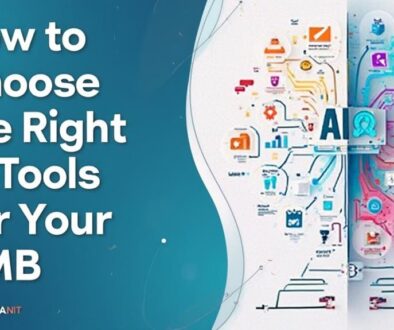AI for SMBs: Overcoming the Common Implementation Challenges
Implementing AI in small and medium-sized businesses (SMBs) presents notable challenges, including limited resources, integration difficulties, and a shortage of technical expertise. SMBs can overcome these hurdles by prioritizing targeted investments and leveraging strategic partnerships, which can provide necessary AI tools and knowledge. Gradual adoption along with effective training enhances staff confidence, making the shift smoother. Additionally, ensuring data quality and integration with existing systems is crucial for success. By addressing these common obstacles, SMBs can harness the power of AI to drive innovation and competitiveness. Explore further strategies to optimize your approach and maximize benefits.
Key Takeaways
- Leverage technology partnerships and outsourcing to access AI expertise without hiring in-house personnel, optimizing resource allocation for SMBs.
- Start small by implementing AI solutions in targeted areas, allowing for gradual investment and quick wins without overwhelming budgets.
- Invest in robust data management systems to improve data quality and accessibility, ensuring effective AI insights and decision-making.
- Foster a culture of continuous learning through training programs and mentoring, enhancing technical expertise and confidence among employees.
- Address resistance to change by communicating the benefits of AI and involving employees in the implementation process to alleviate fears.
Understanding AI Basics

As we explore the world of artificial intelligence (AI), it is essential to establish a clear understanding of its fundamental concepts. AI encompasses a broad range of technologies, with machine learning and neural networks at its core. Machine learning enables systems to learn from data inputs without explicit programming, while neural networks mimic the human brain's structure, improving the efficiency and accuracy of predictions.
Natural language processing (NLP) further enhances AI applications, allowing machines to understand and generate human language in a more intuitive manner. This capability not only improves user experience but also facilitates more effective communication between humans and AI systems. Harnessing predictive analytics, businesses can forecast trends and behaviors, thereby making informed decisions and revealing automation benefits.
However, the integration of AI into daily operations raises important ethical considerations, particularly concerning data privacy. Organizations must strike a balance between leveraging data for improved services and protecting individual privacy rights. Users are increasingly aware of how their information is utilized; consequently, companies should prioritize transparency in their AI implementations.
The evolving landscape of AI presents a myriad of opportunities for small and medium-sized businesses (SMBs) to enhance their operations and competitiveness. By understanding AI fundamentals, businesses can navigate the complexities of these technologies, aligning them with their strategic goals while ensuring responsible use.
In doing so, they not only optimize processes but also contribute to a future where data is harnessed ethically, fostering innovation and freedom of enterprise.
Identifying Implementation Challenges
Implementing AI solutions in small and medium-sized businesses often presents significant hurdles, primarily due to a lack of resources and challenges in integrating these technologies with existing systems.
Without adequate funding and skilled personnel, organizations may struggle to adopt AI effectively, leading to underwhelming results.
Moreover, seamless integration is critical; failure to align new AI tools with established workflows can render investments ineffective, highlighting the need for thoughtful planning and execution.
Lack of Resources
While many small and medium-sized businesses (SMBs) recognize the potential benefits of artificial intelligence (AI), the lack of resources often serves as a significant barrier to successful implementation.
A limited budget and workforce can hinder effective resource allocation, forcing businesses to make tough decisions about where to invest their efforts.
To navigate this challenge, SMBs can focus on the following key strategies:
- Outsourcing Options: Collaborate with specialized firms that can provide the necessary AI expertise without the overhead of hiring in-house staff.
- Technology Partnerships: Engage with technology vendors who offer extensive solutions, reducing the burden on internal resources.
- Training Programs: Invest in skill development initiatives to empower employees, enhancing team collaboration and ensuring they feel confident handling AI tools.
- Process Optimization: Review and streamline existing workflows to maximize efficiency, allowing for improved time management and project management.
Integration With Existing Systems
Integrating artificial intelligence (AI) solutions into existing systems presents a formidable challenge for small and medium-sized businesses (SMBs). To navigate this landscape, conducting a thorough AI compatibility assessment is essential. This process begins with a system architecture evaluation, ensuring that existing frameworks can support advanced technologies without compromising functionality.
One major hurdle is addressing legacy system challenges, which often rely on outdated infrastructure that can hinder progress. An integration frameworks comparison will reveal potential fits or roadblocks, allowing businesses to choose the most suitable path that minimizes disruptions.
Additionally, executing data pipeline optimization is vital, as this enables seamless data flow necessary for AI-driven insights.
Furthermore, achieving third-party software interoperability expands the scope of potential applications, allowing SMBs to leverage existing tools efficiently. Automation potential analysis becomes imperative to identify which processes are ripe for streamlining, enhancing productivity without overwhelming resources.
Budget Constraints and Solutions

For many small and medium-sized businesses (SMBs), budget constraints serve as a considerable barrier to adopting AI technologies. The perception that AI is prohibitively expensive can stifle innovation and prevent organizations from harnessing its transformative potential.
Nevertheless, with careful budget planning and a keen eye for cost-effective solutions, SMBs can navigate these challenges successfully. Here are four strategies to contemplate:
- Start Small: Implementing AI in targeted areas can yield quick wins without overwhelming the budget. This incremental approach allows for gradual investment and reduces financial risk.
- Leverage Open-Source Tools: Many powerful, open-source AI tools are available at little to no cost. Utilizing these resources can markedly lower expenses while still delivering robust functionalities.
- Collaborate with Startups: Partnering with emerging AI companies often provides access to innovative solutions at a fraction of the cost when compared to established providers. These collaborations enable SMBs to benefit from cutting-edge technologies while managing expenditures effectively.
- Optimize Current Resources: Evaluating existing technology and streamlining processes can free up funds for AI investments. This guarantees that the financial commitment toward AI does not strain other critical areas of operation.
Lack of Technical Expertise
Steering through the landscape of AI implementation can be particularly challenging for small and medium-sized businesses (SMBs) due to a widespread lack of technical expertise. This gap often hinders SMBs from harnessing AI's transformative power, resulting in missed opportunities that larger enterprises may exploit.
However, this challenge can also be turned into an opportunity for growth and innovation through effective strategies.
Leveraging technical partnerships with specialized firms can provide SMBs with the expertise needed to navigate AI complexities. These partnerships can enable access to advanced tools and insights that are otherwise out of reach.
Likewise, exploring outsourcing options allows businesses to delegate technical tasks to professionals, freeing up internal resources for other critical operations.
Moreover, investing in mentoring programs and knowledge sharing with industry veterans can greatly enhance an organization's technical skill set. Skill-building workshops and online courses offer invaluable pathways for the workforce to gain practical AI knowledge and stay relevant in an evolving tech landscape.
Community resources and peer networks can also facilitate collaborative projects, fostering an environment of shared learning and innovation.
Establishing certification pathways encourages employees to advance their skills formally, ensuring that the business remains competitive.
Overall, while the lack of technical expertise poses challenges for SMBs, embracing these strategies can position them to effectively overcome barriers and thrive in the AI-driven landscape.
Data Quality and Accessibility

Data quality and accessibility stand as critical linchpins in the effective implementation of AI for small and medium-sized businesses (SMBs).
The strategies used for data collection must prioritize accuracy and relevance to enable meaningful insights, while accessible solutions are essential for fostering an inclusive data culture within the organization.
Addressing these challenges is not merely beneficial but essential for SMBs aiming to leverage AI's full potential.
Data Collection Strategies
Steering through the complexities of AI implementation in small and medium-sized businesses (SMBs) hinges on the effectiveness of data collection strategies, particularly concerning data quality and accessibility.
A robust strategy not only guarantees superior data integrity but also empowers SMBs to harness data as a strategic asset. Here are four critical components:
- Diverse Data Sources: Utilize various data sources, including customer feedback and market surveys, to enhance data richness.
- Effective Collection Methods: Employ automation tools and survey techniques to streamline data acquisition while maintaining data governance standards.
- Privacy Considerations: Before collection, ascertain compliance with privacy regulations to uphold trust and data ownership, safeguarding the interests of all stakeholders.
- Real-time Monitoring and Integration: Leverage analytics platforms for real-time monitoring and data integration, enabling rapid insights and agile decision-making.
Ensuring Data Accuracy
Guaranteeing data accuracy is foundational to the successful implementation of AI in small and medium-sized businesses (SMBs). Accurate data empowers decision-making, enables effective customer engagement, and drives operational efficiency. To achieve this, SMBs must adopt robust data management frameworks that incorporate rigorous data validation techniques. These techniques are paramount to identifying and rectifying inaccuracies before they feed into AI algorithms.
Furthermore, establishing extensive data governance policies guarantees accountability throughout the data lifecycle. Implementing data cleansing methods and regular data consistency checks reduces errors and enhances data quality.
It is equally essential to engage in transparent data auditing processes to maintain accuracy over time, identifying discrepancies and rectifying them promptly.
To optimize data utilization, effective data integration strategies are fundamental. They guarantee that diverse data sources communicate seamlessly, further enhancing accuracy.
However, the integrity of these systems must be fortified with stringent data security measures, preventing unauthorized access and potential data corruption.
Accessibility Solutions for SMBs
Frequently overlooked, accessibility solutions play a critical role in enhancing data quality for small and medium-sized businesses (SMBs).
By leveraging assistive technologies, SMBs can considerably improve their user experience, guaranteeing customers and employees alike can interact with their digital ecosystem seamlessly.
Prioritizing accessibility not only fulfills ethical responsibilities but also generates tangible business benefits.
Consider these key aspects to effectively implement accessibility solutions:
- Assistive Device Compatibility: Verify that your platforms are compatible with screen readers and other assistive devices to accommodate diverse user needs.
- Training and Awareness: Provide training for employees about the importance of accessibility to foster a more inclusive workplace culture.
- User Feedback Mechanisms: Implement channels for users to provide feedback on accessibility features, helping to continuously adapt and improve offerings.
- Regular Audits: Conduct regular audits to identify and resolve accessibility issues, thereby fortifying data quality and enhancing the overall user experience.
Resistance to Change
Resistance to change often emerges as a formidable barrier during the implementation of AI solutions in small and medium-sized businesses (SMBs). This resistance can stem from various sources, including fear of job displacement, skepticism about technology's effectiveness, and a lack of familiarity with AI.
To navigate these challenges, SMBs must adopt robust change management strategies that foster employee engagement and cultivate a culture conducive to innovation.
Effective leadership support is paramount in alleviating concerns and driving enthusiasm for AI initiatives. Leaders should utilize clear communication strategies, ensuring that employees understand the rationale behind the adoption of AI and how it aligns with organizational goals. Engaging team members in discussions about potential changes can mitigate fears and highlight the benefits of AI to their roles.
A gradual adoption approach can further ease the shift. By implementing AI in stages, employees can become acclimated to new technologies without feeling overwhelmed. Motivation techniques, such as highlighting success stories and providing recognition for adaptable behavior, can also inspire a more positive outlook toward AI integration.
To maintain momentum, organizations should establish feedback loops where employees can voice their concerns and share experiences. Additionally, all-encompassing training programs will equip staff with the necessary skills, fostering confidence and competency.
Ultimately, embracing cultural alignment that values collaboration and innovation will transform resistance into acceptance, paving the way for a successful AI implementation in SMBs.
Selecting the Right AI Tools

Once employees begin to accept the integration of AI into their workflows, the focus must shift to selecting the right AI tools that align with the business's specific needs and goals.
An effective AI tool evaluation process will help guarantee long-term sustainability and success. Here are four key factors to take into account:
- User-Friendly Interfaces: Opt for tools that feature intuitive designs to facilitate easy adoption. A user-friendly interface minimizes the learning curve, empowering employees to leverage AI capabilities seamlessly.
- Industry-Specific Solutions: It's essential to explore AI tools tailored to your sector. These industry-specific solutions are often better equipped to address unique challenges, enhancing efficiency and effectiveness.
- Scalability Considerations: Select platforms that can grow with your business. Scalability is significant; as your SMB expands, so too should your AI capabilities. Confirm the tool can accommodate increased data and user demands over time.
- Vendor Support Options: Investigate the level of support vendors provide. A responsive customer support team can be invaluable, particularly during the initial integration phase and beyond.
Additionally, utilize trial periods to test the integration capabilities and customization features of potential solutions. Customer reviews serve as a valuable resource for insights about real-world performance.
Developing a Clear Strategy
To successfully implement AI within small and medium-sized businesses, it is vital to define precise business objectives that align technology with overall goals.
A thorough assessment of current resources will enable organizations to identify gaps and opportunities, setting a solid foundation for integration.
Additionally, establishing measurable metrics is essential for evaluating progress and effectiveness, ensuring that the AI strategy remains aligned with evolving business needs.
Define Business Objectives
Developing a clear strategy for AI implementation starts with defining business objectives that align with the organization's overall mission. This vital step not only enhances goal alignment but also guarantees that the benefits of AI are tailored to propel your business forward.
A well-structured approach to defining these objectives can drive effective decision-making and optimize resource allocation.
To facilitate this process, consider the following steps:
- Identify Key Challenges: Recognize the specific problems your organization intends to solve with AI.
- Set Measurable Goals: Determine quantifiable targets that will direct your efforts and support performance metrics later on.
- Integrate Stakeholder Input: Involve team members from various departments to gather diverse insights that can inform your objectives.
- Establish Timelines: Create a timeline for achieving these goals, which will foster accountability and keep your team focused.
Assess Current Resources
A thorough assessment of current resources is essential for effective AI implementation in small and medium-sized businesses (SMBs). This resource evaluation serves as a foundational step in developing a clear strategy that aligns technological initiatives with business objectives.
By accurately mapping existing assets through resource mapping, SMBs can identify gaps in capabilities and infrastructure readiness that may hinder progress.
Understanding team capabilities is critical; a skilled workforce is the cornerstone of any successful AI deployment. This necessitates a careful resource assessment, ensuring that not only is the technology inventory robust but also that the right talent is available to leverage these tools effectively.
Resource allocation must be prioritized, focusing on areas where optimization can yield the most significant return on investment. SMBs often face constraints, making it imperative to reveal opportunities for resource optimization — whether it's reallocating budget or enhancing existing systems.
Establish Measurable Metrics
Establishing measurable metrics is essential for SMBs seeking to navigate the complexities of AI implementation effectively. A well-defined strategy anchored in measurable outcomes not only fosters transparency but also enhances stakeholder engagement.
Here are four critical components to focus on:
- Performance Indicators: Identify specific performance indicators tied directly to business objectives, ensuring clear visibility of progress.
- Goal Alignment: Align AI initiatives with overall business goals to reinforce strategic alignment, driving impactful results that resonate across the organization.
- Data Visualization: Utilize data visualization tools to simplify complex information, enabling stakeholders to grasp insights quickly and make informed decisions.
- Continuous Improvement: Establish feedback loops for ongoing outcome evaluation, fostering a culture of continuous improvement.
Training and Upskilling Staff

Many organizations face significant hurdles in effectively training and upskilling their staff for AI integration. The shift towards AI-powered operations demands a workforce equipped with advanced skills, yet many Small and Medium Businesses (SMBs) struggle to foster employee engagement in this vital endeavor.
Implementing robust training programs that emphasize continuous learning is essential for cultivating a culture that embraces technology adoption.
Skill assessment plays a pivotal role in identifying knowledge gaps and tailoring training programs to meet the specific needs of employees. Organizations must encourage knowledge sharing among team members to enhance mutual learning opportunities and support collective progress.
Creating mentorship opportunities can catalyze this process, allowing more experienced staff to guide less seasoned colleagues through the complexities of AI technologies.
Furthermore, performance tracking is integral to underlining the effectiveness of training initiatives. By establishing clear metrics for evaluating employee competencies post-training, businesses can determine the return on investment in professional development.
This not only fosters accountability but also empowers employees to take ownership of their growth, leading to increased engagement and a more profound commitment to the organization.
Measuring Success and ROI
Effectively measuring success and return on investment (ROI) in AI initiatives is essential for SMBs aiming to maximize the value derived from their technological investments. By establishing clear success indicators and thorough ROI calculations, organizations can better assess the impact of their AI projects.
To navigate this complex terrain, consider the following strategies:
- Define Performance Benchmarks: Establish baseline metrics for current operations before implementing AI solutions. These benchmarks will serve as a comparison point for evaluating progress.
- Utilize Data-Driven Insights: Leverage analytics to gather insights on operational efficiency and customer satisfaction. This approach helps in identifying tangible outcomes linked to AI adoption.
- Engage Stakeholders: Actively involve all stakeholders throughout the process. Their feedback fosters a participatory culture, ensuring that inputs align with overall business objectives, thereby refining strategic direction and enhancing buy-in.
- Analyze Case Studies: Conduct comparative analysis by reviewing similar organizations' experiences with AI. Understanding their successes and pitfalls can provide valuable lessons and inform your own path forward.
The implementation of robust financial metrics is also essential to ascertain long-term benefits and validate the business case surrounding AI initiatives.
Creating feedback loops facilitates ongoing improvement, transforming AI from a static solution to a dynamic, value-generating component of the business strategy.
Ultimately, a commitment to evolving measurement frameworks will empower SMBs to harness the full potential of AI, ensuring sustained growth and development.
Frequently Asked Questions
How Can AI Improve Customer Engagement for Smbs?
AI can considerably enhance customer engagement for SMBs by facilitating personalized marketing strategies.
By harnessing customer insights derived from data analysis, businesses can tailor their communications and offerings to meet individual preferences and behaviors. This targeted approach not only boosts customer satisfaction but also fosters loyalty, enabling SMBs to cultivate deeper relationships with their audience.
Ultimately, leveraging AI allows these enterprises to operate more dynamically and effectively in a competitive marketplace, promoting both growth and customer autonomy.
What Industries Benefit the Most From AI Implementations?
In today's rapidly evolving landscape, industries like manufacturing, retail, and healthcare are reaping significant benefits from AI implementations.
Manufacturing optimization streamlines production processes, while retail analytics enhances customer insights.
In healthcare diagnostics, AI improves accuracy and expedites treatment.
Financial forecasting aids in robust decision-making, and logistics management boosts supply chain efficiency.
Ultimately, marketing automation enables targeted campaigns, fostering engagement.
These applications empower businesses, enabling them to thrive with newfound freedom in their operational strategies.
Are There Any AI Solutions Tailored Specifically for Smbs?
Yes, there are AI solutions specifically designed for small and medium-sized businesses (SMBs).
These AI tools provide scalable options that align with cost considerations and are tailored to fit SMB platforms. Many solutions also include user training resources to facilitate smooth integration processes, ensuring that SMBs can leverage AI effectively without extensive technical knowledge.
How Do I Ensure Data Privacy During AI Implementation?
Ensuring data privacy during AI implementation is vital. Organizations must prioritize data security by implementing robust encryption methods and access controls to protect sensitive information.
Additionally, adherence to compliance measures such as GDPR or CCPA is essential, guaranteeing that personal data is handled responsibly.
Regular audits and employee training further bolster privacy efforts, fostering a culture of awareness and accountability.
What Are the Signs of Successful AI Integration in a Business?
Successful AI integration in a business is akin to a well-tuned orchestra; when the performance indicators align, the result is harmonious and impactful.
Key integration metrics, such as increased efficiency and improved customer satisfaction, serve as benchmarks. Engaged employees and enhanced decision-making processes further signify positive outcomes.
Observing these elements indicates that AI is not merely present, but effectively enhancing operations, thereby empowering the organization to embrace innovation and achieve greater freedom in its strategies.
Conclusion
The journey of integrating AI into small and medium-sized businesses demands a steadfast commitment to overcoming challenges. By maneuvering budget constraints and cultivating technical expertise, while ensuring data quality and selecting suitable tools, success becomes attainable. Developing a clear strategy and investing in staff training transforms obstacles into opportunities. Measuring success and evaluating ROI paves the way for continuous improvement. Ultimately, a systematic approach fosters resilience, innovation, and sustained growth in an increasingly competitive landscape.




